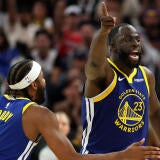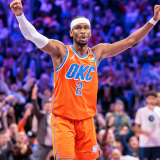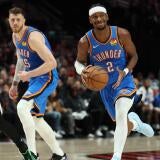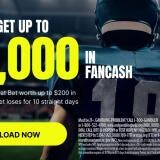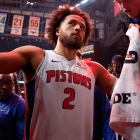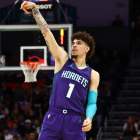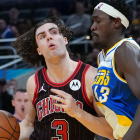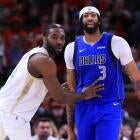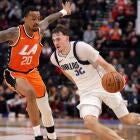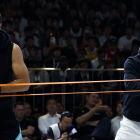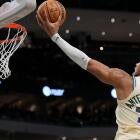Pelicans' Zion Williamson produced like a star in his rookie season, but he could come back much more refined
We haven't seen anything from the Williamson yet
For 19 games, Zion Williamson was an inferno. He finished over, around and through players who are paid primarily to protect the rim. He ran faster and jumped higher than any 285-pound person should be able to, and he made an art form out of sealing his defender near the rim in transition. His alley-oops and early post-ups felt almost unethical, as if the New Orleans Pelicans were exploiting a loophole by putting someone that massive and explosive near the basket.
At 19 years old, Williamson averaged 23.6 points, 6.8 rebounds and 2.2 assists in 29.7 minutes. He attempted 13 shots a game in the restricted area and made 63 percent of them. With him on the court, the Pelicans outscored opponents by 10.4 points per 100 possessions, a slightly better margin than the Los Angeles Lakers posted with LeBron James on the court. Rookies are not supposed to do any of this.
And yet it's easy to nitpick Williamson's game. Outside of a stunning barrage from 3-point range in the fourth quarter of his regular-season debut, he barely scored outside the paint. He shot just 64.5 percent from the free-throw line. He turned the ball over too much, didn't impress on defense and wasn't even in great shape. He will get so much better.
This week on this website, Brad Botkin wrote about Trae Young getting off the ball, Jasmyn Wimbish wrote how Luka Doncic can become a better team defender and Sam Quinn wrote about Jayson Tatum needing to improve as a passer. Williamson's next step is not as straightforward as any of theirs, and his upside is so absurd that it's difficult to discuss without sounding like a lunatic. He has been compared to Charles Barkley, Draymond Green, Shaquille O'Neal and Vince Carter. There is no precedent for a player who moves like him at his size. In a few years, he could be the face of the league.
Defense
Williamson had higher defensive expectations than any prospect in years. He was billed as a Draymond type, who could blow up opponents' plays and capably guard all five positions. In this respect, he fell short.
Compared to his year at Duke, Williamson didn't make crazy defensive plays nearly as often, and he certainly wasn't some kind of roving menace as a help defender. He was fairly switchable, but he wasn't much of a rim protector and was mistake-prone off the ball.
The question is how much of this was about conditioning and how much of it was about adjusting to the pros. Young players are typically poor defenders, even if they look the part. Williamson was supposed to be an exception to that rule, but either wasn't thinking fast enough or couldn't expend the necessary energy.
This brings us to Jake Layman and Jordan McLaughlin, two reserves on the 19-45 Minnesota Timberwolves.
A week before the shutdown, the Pelicans hosted Minnesota. In the second quarter, Layman beat Williamson on a backdoor cut, but Williamson recovered when Layman mishandled the pass:
Less than a minute later, Layman went backdoor again because Williamson's head was turned:
New Orleans visited the Wolves a week later, and once again Williamson was matched up with Layman in the second quarter. Almost immediately, Layman fooled Williamson with a cut. It would have been a highlight if not for the uncalled foul:
Less than a minute later, Layman got his highlight because of a bad closeout by Williamson. Poor Derrick Favors:
In the first game, McLaughlin came off the bench to score 13 points on 6-for-7 shooting with six assists in 20 minutes. He did much of his damage by going at Williamson. First, McLaughlin attacked him off a switch:
And then McLaughlin targeted him in pick-and-rolls:
The Pelicans' defensive numbers with Williamson on the court were good, but the credit for that should mostly go to Jrue Holiday, Lonzo Ball and Favors. If the season had continued and New Orleans had snuck into the playoffs, Williamson would have been hunted, and his mistakes would have been under the microscope.
Offense
Williamson is a terrifying sight when he has a head of steam, and he is nimble enough to make destroying an entire defense look easy:
You've seen him bully bigs on the block. You've seen his burst and his out-of-this-galaxy second jump. He's a willing passer, too, and he didn't disrupt Brandon Ingram's rhythm when he returned from injury. But he has flaws, the most glaring of which is his shooting. And if he's going to become a primary offensive option, he's going to need to grow as a ballhandler, too. His offensive repertoire is effective, but predictable.
On March 4 against the Dallas Mavericks, Williamson got two early buckets against Maxi Kleber driving baseline. Then he went middle and missed wildly:
Kleber continued to stand his ground against Williamson, and the Mavericks sent help. Williamson finished the game 9 for 18, but seemed frustrated when he didn't get calls and his shots got blocked:
He even settled for a couple of jumpers, which didn't end well:
That was Williamson's only back-to-back of the season. He might've been tired. The scouting report on him, though, is straightforward: He doesn't want to shoot from the perimeter, and he always wants to finish with his left hand. Here, the Wolves' Naz Reid and Juancho Hernangomez stifle him twice:
And here, Dwight Howard stays in front of him and slaps the ball out of his hands in two different games:
With Williamson on the court, the Pelicans had a 16.6 percent turnover rate, which is slightly higher than the Cleveland Cavaliers' league-worst mark. That's partially a product of them running like maniacs, but Williamson has a tendency to get ahead of himself in both transition and the halfcourt. Take these three flavors of turnover in the second half against the Miami Heat on March 6:
Williamson will clean some of this up, just like he'll become more active rather than reactive on defense. As long as he stays healthy, he'll be a fixture on the difficult-to-crack Western Conference All-Star team. Now imagine if he refines his game.


